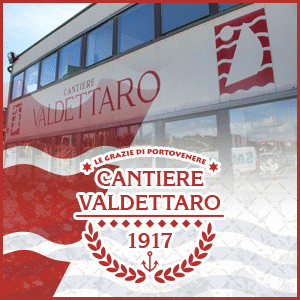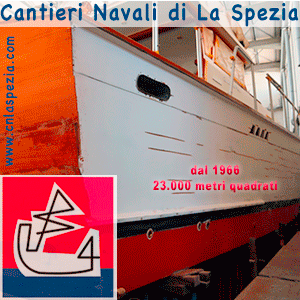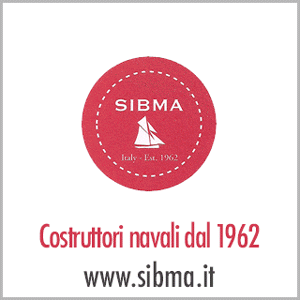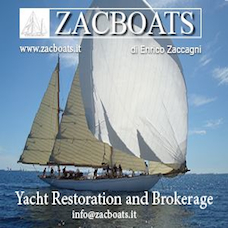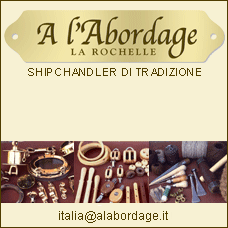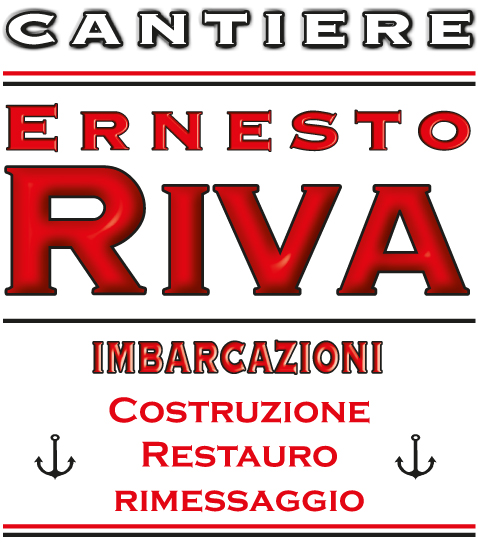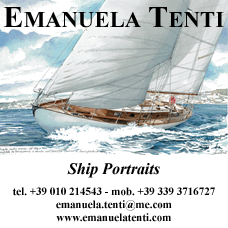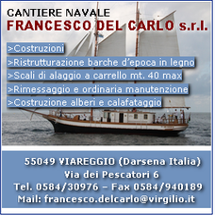 1962-2017. Nel 2017 la Sibma Navale Italiana di Dolcedo, nell’entroterra ligure alle spalle di Imperia, festeggia un doppio compleanno. Il noto cantiere specializzato nella realizzazione e nel restauro di scafi in legno, fondato da Ernesto Quaranta nel 1962, compie infatti 55 anni, stessa età del figlio Mario, l’attuale titolare. Oltre alla costruzione dei motoryacht classici della serie Armstrong e al recupero di scafi storici, la Sibma Navale si conferma come il principale referente per il restauro e la manutenzione delle barche a vela classe Dragone. Oggi, accanto a Mario Quaranta, si sta formando la terza generazione. Il giovane figlio Andrea, regatante insieme al padre, è infatti coinvolto a pieno ritmo nelle attività del cantiere.
1962-2017. Nel 2017 la Sibma Navale Italiana di Dolcedo, nell’entroterra ligure alle spalle di Imperia, festeggia un doppio compleanno. Il noto cantiere specializzato nella realizzazione e nel restauro di scafi in legno, fondato da Ernesto Quaranta nel 1962, compie infatti 55 anni, stessa età del figlio Mario, l’attuale titolare. Oltre alla costruzione dei motoryacht classici della serie Armstrong e al recupero di scafi storici, la Sibma Navale si conferma come il principale referente per il restauro e la manutenzione delle barche a vela classe Dragone. Oggi, accanto a Mario Quaranta, si sta formando la terza generazione. Il giovane figlio Andrea, regatante insieme al padre, è infatti coinvolto a pieno ritmo nelle attività del cantiere.
Di Paolo Maccione – Marzo 2017
Fotografie Paolo Maccione e Archivio Barche d’Epoca e Classiche
ITALIAN/ENGLISH TEXT
Sibma Navale, dalle barche a spigolo ai restauri di vele d’epoca  Un anniversario che rappresenta un traguardo e che conferma questo cantiere come uno dei più importanti e storici a livello internazionale. Nel 2017 la Sibma Navale Italiana, fondata a Torino nel 1962 dall’ingegnere Ernesto Quaranta (scomparso nel 2006), compie infatti 55 anni. Tanti quanti sono gli anni di Mario Quaranta, l’attuale titolare, anch’egli ingegnere. L’inizio dell’attività di famiglia è infatti coincisa con la sua nascita a Torino, quasi come se i suoi genitori avessero pensato di fargli un ‘regalo’ decisamente particolare: un cantiere navale. Nel corso degli anni questa realtà è diventata famosa grazie alla costruzione e commercializzazione delle imbarcazioni a vela classe Promenade, EM7 e EM850. La vendita in kit di questi scafi in compensato marino ‘a spigolo’ ha contribuito a diffondere la pratica della navigazione da diporto a intere generazioni.
Un anniversario che rappresenta un traguardo e che conferma questo cantiere come uno dei più importanti e storici a livello internazionale. Nel 2017 la Sibma Navale Italiana, fondata a Torino nel 1962 dall’ingegnere Ernesto Quaranta (scomparso nel 2006), compie infatti 55 anni. Tanti quanti sono gli anni di Mario Quaranta, l’attuale titolare, anch’egli ingegnere. L’inizio dell’attività di famiglia è infatti coincisa con la sua nascita a Torino, quasi come se i suoi genitori avessero pensato di fargli un ‘regalo’ decisamente particolare: un cantiere navale. Nel corso degli anni questa realtà è diventata famosa grazie alla costruzione e commercializzazione delle imbarcazioni a vela classe Promenade, EM7 e EM850. La vendita in kit di questi scafi in compensato marino ‘a spigolo’ ha contribuito a diffondere la pratica della navigazione da diporto a intere generazioni.
La base nel ponente ligure  Oggi la Sibma Navale fa base nel ponente ligure a Dolcedo, alle spalle di Imperia. È qui che vengono realizzati importanti restauri di scafi d’epoca come nel caso di Ea, il cutter bermudiano costruito nel 1952 dal cantiere Baglietto di Varazze, sottoposto tra il 2006 e il 2008 a grandi lavori. Da diversi anni Ea partecipa e vince in occasione delle regate di vele d’epoca e classiche. Oggi accanto a Mario Quaranta lavora anche il figlio Andrea, classe 1995, ormai coinvolto a pieno titolo nelle attività del cantiere. Insieme al padre partecipa alle regate a bordo del loro Dragone ‘Little Diva’. E i risultati non possono altro che essere definiti lusinghieri, considerato che Mario Quaranta rientra tra gli unici cinque timonieri italiani (gli altri sono Giuseppe Duca, Nando Colaninno, Fabio Mangione e Alberto Marconi) abilitati a partecipare, in base all’International Ranking List 2016, al Campionato del Mondo dei Dragoni in programma a Cascais, in Portogallo, dal 9 al 17 giugno 2017.
Oggi la Sibma Navale fa base nel ponente ligure a Dolcedo, alle spalle di Imperia. È qui che vengono realizzati importanti restauri di scafi d’epoca come nel caso di Ea, il cutter bermudiano costruito nel 1952 dal cantiere Baglietto di Varazze, sottoposto tra il 2006 e il 2008 a grandi lavori. Da diversi anni Ea partecipa e vince in occasione delle regate di vele d’epoca e classiche. Oggi accanto a Mario Quaranta lavora anche il figlio Andrea, classe 1995, ormai coinvolto a pieno titolo nelle attività del cantiere. Insieme al padre partecipa alle regate a bordo del loro Dragone ‘Little Diva’. E i risultati non possono altro che essere definiti lusinghieri, considerato che Mario Quaranta rientra tra gli unici cinque timonieri italiani (gli altri sono Giuseppe Duca, Nando Colaninno, Fabio Mangione e Alberto Marconi) abilitati a partecipare, in base all’International Ranking List 2016, al Campionato del Mondo dei Dragoni in programma a Cascais, in Portogallo, dal 9 al 17 giugno 2017.
Il cantiere di appoggio per i Dragonisti d’Europa Oltre alla costruzione di derive in legno e dei motoryacht classici in stile ‘trawler’ della serie Armstrong, da oltre 10 anni la Sibma Navale, grazie anche a un accordo con il cantiere inglese Petticrows Ltd, è diventata punto di riferimento internazionale per i Dragonisti di tutta Europa, ai quali fornisce assistenza diretta oltre alla possibilità di manutenzione, rimessaggio e restauro. Il Dragone è un monotipo lungo 8,90 metri, armato a sloop bermudiano, progettato nel 1929 dal norvegese Johan Anker . Con oltre 6300 esemplari varati è diventato il monotipo a chiglia più diffuso al mondo. Tra il 1929 e il 2016 in Italia sono stati immatricolati 70 Dragoni (ITA-70). Riguardo il Dragone, così come per altre classi monotipo, spesso si dice: “Il problema con le regate One-Design è che il miglior velista di solito vince”. Presso la Sibma Navale ogni anno si lavora su una quindicina di Dragoni e si conta che fino ad oggi le maestranze del cantiere siano intervenute su una cinquantina di Dragoni. Tra i più recenti interventi quello effettuato sul Dragone Corail, costruito dal cantiere svizzero Wirtz nel 1967. La barca, realizzata in fasciame di mogano su ordinate di frassino e con la coperta in teak, regaterà in Liguria. Dragoni classici come questo possono essere molto diversi l’uno dall’altro, anche se il peso per ognuno si aggira intorno ai 1700 chilogrammi. Ormai montano tutti un albero in alluminio e le vere differenze si riscontrano a livello dell’attrezzatura e della possibilità o meno di avere subìto ‘upgrade strutturali’ per renderli più competitivi.
Oltre alla costruzione di derive in legno e dei motoryacht classici in stile ‘trawler’ della serie Armstrong, da oltre 10 anni la Sibma Navale, grazie anche a un accordo con il cantiere inglese Petticrows Ltd, è diventata punto di riferimento internazionale per i Dragonisti di tutta Europa, ai quali fornisce assistenza diretta oltre alla possibilità di manutenzione, rimessaggio e restauro. Il Dragone è un monotipo lungo 8,90 metri, armato a sloop bermudiano, progettato nel 1929 dal norvegese Johan Anker . Con oltre 6300 esemplari varati è diventato il monotipo a chiglia più diffuso al mondo. Tra il 1929 e il 2016 in Italia sono stati immatricolati 70 Dragoni (ITA-70). Riguardo il Dragone, così come per altre classi monotipo, spesso si dice: “Il problema con le regate One-Design è che il miglior velista di solito vince”. Presso la Sibma Navale ogni anno si lavora su una quindicina di Dragoni e si conta che fino ad oggi le maestranze del cantiere siano intervenute su una cinquantina di Dragoni. Tra i più recenti interventi quello effettuato sul Dragone Corail, costruito dal cantiere svizzero Wirtz nel 1967. La barca, realizzata in fasciame di mogano su ordinate di frassino e con la coperta in teak, regaterà in Liguria. Dragoni classici come questo possono essere molto diversi l’uno dall’altro, anche se il peso per ognuno si aggira intorno ai 1700 chilogrammi. Ormai montano tutti un albero in alluminio e le vere differenze si riscontrano a livello dell’attrezzatura e della possibilità o meno di avere subìto ‘upgrade strutturali’ per renderli più competitivi.
Il restauro del Dragone Venilia  Venilia è un Dragone costruito dal cantiere danese Børresen nel 1956. Ha sempre regatato in Italia e in particolare nella zona del Tirreno. L’imbarcazione, ritrovata nel 2016 in un capannone in Liguria, dopo essere stata periziata da Mario Quaranta è stata acquistata affinchè si procedesse ad un restauro integrale. Tra i lavori effettuati la sostituzione del fasciame in mogano dello spessore di 16 millimetri e di oltre 30 ordinate realizzate in legno di frassino. Per gli incollaggi e il serraggio delle varie componenti verranno impiegate resine epossidiche, viteria in acciaio inox e ribattini in rame. Originariamente Venilia aveva la coperta verniciata e così tornerà ad essere, ovvero in compensato marino di mogano con applicato un sottile strato di tela biassiale e antisdrucciolo. L’attrezzatura velica sarà del tipo ‘top race condition’. Per permetterle di regatare al massimo livello in tutte le condizioni si procederà infatti a realizzare tutti i necessari irrigidimenti strutturali, nel pieno rispetto del regolamento di classe. In questa barca, che tornerà in mare entro l’estate 2017, è riassunta e concentrata tutta l’esperienza della Sibma Navale in fatto di Dragoni.
Venilia è un Dragone costruito dal cantiere danese Børresen nel 1956. Ha sempre regatato in Italia e in particolare nella zona del Tirreno. L’imbarcazione, ritrovata nel 2016 in un capannone in Liguria, dopo essere stata periziata da Mario Quaranta è stata acquistata affinchè si procedesse ad un restauro integrale. Tra i lavori effettuati la sostituzione del fasciame in mogano dello spessore di 16 millimetri e di oltre 30 ordinate realizzate in legno di frassino. Per gli incollaggi e il serraggio delle varie componenti verranno impiegate resine epossidiche, viteria in acciaio inox e ribattini in rame. Originariamente Venilia aveva la coperta verniciata e così tornerà ad essere, ovvero in compensato marino di mogano con applicato un sottile strato di tela biassiale e antisdrucciolo. L’attrezzatura velica sarà del tipo ‘top race condition’. Per permetterle di regatare al massimo livello in tutte le condizioni si procederà infatti a realizzare tutti i necessari irrigidimenti strutturali, nel pieno rispetto del regolamento di classe. In questa barca, che tornerà in mare entro l’estate 2017, è riassunta e concentrata tutta l’esperienza della Sibma Navale in fatto di Dragoni.
Bimini Kid, il Bertram 31 arrivato dall’America  Verso la fine del 2015 un armatore ligure ha acquistato a New York Bimini Kid, un modello di Bertram 31 in vetroresina del 1974, storica imbarcazione a motore realizzata dall’omonimo cantiere che ha fatto la storia della nautica internazionale. Quello che è unanimemente considerato uno dei modelli di fisherman più belli al mondo è stato trasferito alla Sibma Navale per essere sottoposto a un restauro integrale che ha riguardato la ricostruzione degli interni e degli esterni, a partire dal pozzetto, dall’impiantistica e dalla motorizzazione. Ricostruite integralmente, in superlamellare di mogano, le finestrature tra il ponte e il flying bridge. La barca tornerà a navigare nel 2017 e, considerata la sua storicità, potrebbe presto partecipare a una serie di eventi e manifestazioni dedicate alle barche storiche americane.
Verso la fine del 2015 un armatore ligure ha acquistato a New York Bimini Kid, un modello di Bertram 31 in vetroresina del 1974, storica imbarcazione a motore realizzata dall’omonimo cantiere che ha fatto la storia della nautica internazionale. Quello che è unanimemente considerato uno dei modelli di fisherman più belli al mondo è stato trasferito alla Sibma Navale per essere sottoposto a un restauro integrale che ha riguardato la ricostruzione degli interni e degli esterni, a partire dal pozzetto, dall’impiantistica e dalla motorizzazione. Ricostruite integralmente, in superlamellare di mogano, le finestrature tra il ponte e il flying bridge. La barca tornerà a navigare nel 2017 e, considerata la sua storicità, potrebbe presto partecipare a una serie di eventi e manifestazioni dedicate alle barche storiche americane.
Baltic, il rimorchiatore diventa imbarcazione da diporto  La Sibma Navale è stata scelta per progettare e seguire il restauro di Baltic, un rimorchiatore in acciaio lungo 27 metri costruito nel 1963 dal cantiere norvegese Westermoen Batbyggeri & Mek Mandal per conto della Esso Petroli. Dal 2014 l’unità, che disloca circa 180 tonnellate e ha un’immersione pari a 3,10 metri, è in corso di riconversione in unità da diporto presso un cantiere in Francia, a La Ciotat. Qui si sta procedendo alla sostituzione del 30% delle lamiere dello scafo dello spessore di 10 millimetri, alla realizzazione delle nuove compartimentazioni interne, alla posa di nuovi serbatoi per un totale di 24.000 litri di carburante, dei ballast e di due propulsori Man da 800 cavalli l’uno che gli permetteranno di navigare a circa 10 nodi di velocità, con un consumo previsto di circa 60 litri/ora di gasolio. L’ex rimorchiatore potrà imbarcare 8000 litri di acqua, con serbatoi per le acque nere di capacità pari a 2500 litri, e sarà in grado di produrre 360 litri/ora di acqua desalinizzata. Gli ampi volumi permetteranno di ricavare quattro cabine doppie, una cabina quadrupla, una cabina per il comandante e un alloggio per 2 membri di equipaggio. Una volta completati i lavori strutturali, Baltic verrà trasferito a Imperia, dove le maestranze del cantiere procederanno alla ricostruzione degli interni.
La Sibma Navale è stata scelta per progettare e seguire il restauro di Baltic, un rimorchiatore in acciaio lungo 27 metri costruito nel 1963 dal cantiere norvegese Westermoen Batbyggeri & Mek Mandal per conto della Esso Petroli. Dal 2014 l’unità, che disloca circa 180 tonnellate e ha un’immersione pari a 3,10 metri, è in corso di riconversione in unità da diporto presso un cantiere in Francia, a La Ciotat. Qui si sta procedendo alla sostituzione del 30% delle lamiere dello scafo dello spessore di 10 millimetri, alla realizzazione delle nuove compartimentazioni interne, alla posa di nuovi serbatoi per un totale di 24.000 litri di carburante, dei ballast e di due propulsori Man da 800 cavalli l’uno che gli permetteranno di navigare a circa 10 nodi di velocità, con un consumo previsto di circa 60 litri/ora di gasolio. L’ex rimorchiatore potrà imbarcare 8000 litri di acqua, con serbatoi per le acque nere di capacità pari a 2500 litri, e sarà in grado di produrre 360 litri/ora di acqua desalinizzata. Gli ampi volumi permetteranno di ricavare quattro cabine doppie, una cabina quadrupla, una cabina per il comandante e un alloggio per 2 membri di equipaggio. Una volta completati i lavori strutturali, Baltic verrà trasferito a Imperia, dove le maestranze del cantiere procederanno alla ricostruzione degli interni.
Pronto al varo il più grande degli Armstrong  I motoryacht Armstrong rappresentano un vanto per la Sibma Navale. Questa serie di scafi, costruiti in lamellare di mogano, si sono rivelati ideali per chi desidera una barca classica, marina e molto comoda, al punto da poterla definire una barca-casa. Fino ad ora sono stati realizzati un Armstrong lungo 7,50 metri (l’unico in vetroresina), 4 Armstrong 10 metri, 2 Armstrong 12,50 metri e un Armstrong lungo 13,50 metri. La costruzione di quest’ultimo esemplare, ammiraglia del cantiere, è stata completata recentemente e l’unità comincerà a navigare entro l’estate. Tra le varie caratteristiche la doppia tuga finestrata, un ampio pozzetto poppiero, la timoneria interna, un ampio prendisole prodiero e la scala di accesso al flying bridge che all’occorrenza si trasforma in scaletta di discesa a mare sul lato sinistro.
I motoryacht Armstrong rappresentano un vanto per la Sibma Navale. Questa serie di scafi, costruiti in lamellare di mogano, si sono rivelati ideali per chi desidera una barca classica, marina e molto comoda, al punto da poterla definire una barca-casa. Fino ad ora sono stati realizzati un Armstrong lungo 7,50 metri (l’unico in vetroresina), 4 Armstrong 10 metri, 2 Armstrong 12,50 metri e un Armstrong lungo 13,50 metri. La costruzione di quest’ultimo esemplare, ammiraglia del cantiere, è stata completata recentemente e l’unità comincerà a navigare entro l’estate. Tra le varie caratteristiche la doppia tuga finestrata, un ampio pozzetto poppiero, la timoneria interna, un ampio prendisole prodiero e la scala di accesso al flying bridge che all’occorrenza si trasforma in scaletta di discesa a mare sul lato sinistro.
Gallery
Visita il sito - Contatti
www.sibma.it , E-mail: info@sibma.it Tel. (cantiere) +39 0183 280124
Cell. (Mario Quaranta) +39 3389353087
ENGLISH TEXT
Wooden boatbuilding, restorations and Dragons:
the Italian Sibma Navale yard celebrates 55 years of activity!
1962-2017. Sibma Navale Italiana, located in Dolcedo, a town in the Ligurian interior near Imperia, is celebrating two birthdays. Founded by Ernesto Quaranta in 1962, the well-known yard specialized in building and restoring wooden boats celebrates its 55th birthday, the same number of years as Ernesto’s son Mario, the yard’s present owner. As well as building Armstrong classic motor yachts and restoring vintage yachts, Sibma Navale is also the leader in restoring and maintaining Dragon class sailboats. Today, alongside Mario Quaranta, the third generation is already at work. His young son Andrea, a sailor like his father, is working at full swing in the family yard.
By Paolo Maccione – March 2017
Photographs by Paolo Maccione and the Archivio Barche d’Epoca e Classiche
Sibma Navale, from kits to vintage restoration
An anniversary as an objective, a confirmation of the yard as one of the most important historic shipyards in the international panorama. Founded in Turin in 1962 by the engineer Ernesto Quaranta, in 2017 Sibma Navale Italiana celebrates their 55th year of activity. That’s also the age of Mario Quaranta, present owner and an engineer like his father. The family business began the year of Mario’s birth in Turin, almost as if his parents had decided to give him a special present: a shipyard. Through the years Sibma Navale became famous thanks to the construction and sales of Promenade, EM7 and EM850 class sailboats. Kit sales of these chined, plywood sailboats helped diffuse the pleasure of sailing to entire generations.
The base in western Liguria
Sibma Navale is located in western Liguria at Dolcedo, just inland from Imperia. Here is where the Quaranta’s restore important vintage yachts. A prime example is Ea, the bermuda cutter built in 1952 at Baglietto in Varazze. Ea underwent an important refit in Dolcedo from 2006 until 2008. Over the years Ea has participated in many events, winning several, during the classic and vintage regatta seasons. Today, Mario Quaranta’s son Andrea works by his father’s side. Born in 1995, Andrea is fully involved in the running of the yard and racing their Dragon Little Diva with his father. With gratifying results: Mario is one of only five Italian skippers rating high enough on the 2016 International Ranking List to enter the 2017 Dragon Worlds in Cascais, Portugal, this June. (The other skippers are Giuseppe Duca, Nando Colaninno, Fabio Mangione and Alberto Marconi!)
The European Dragon’s support yard
While continuing their construction of wooden dinghies and classic trawler style Armstrong motor yachts, thanks to an agreement with Petticrows Ltd., for more than 10 years Sibma Navale has been the international support yard for the European Dragon fleet, carrying out maintenance, wintering, restorations and direct assistance. The Dragon is an 8.9 meter one-design sloop, designed in 1929 by Johan Anker. More than 6,300 have been built, making the Dragon the largest one-design keelboat in the world. 70 Dragons have been rated in Italy since its launch. It is often heard, when speaking of one-designs, that “the problem with one-design racing is that usually the best sailor wins”. At Sibma Navale fifteen Dragons pass through the yard every year and the yard’s shipwrights have worked on more then fifty Dragons all told. Recently work was done on the Dragon Corail, built by the Swiss Wirtz yard in 1967. With mahogany planking over ash frames and a teak deck, she will be racing in Liguria. Individual classic Dragons can differ considerably, even though they all weigh in at about 1,700 kilograms. Masts are in aluminum nowadays, and the true differences are to be found in their hardware and rigging, and whether or not they’ve had a “structural upgrade” to make them more competitive.
The restoration of the Dragon Venilia
Venilia was built by the Danish Børresen yard in 1956. She has always raced in Italy, primarily in the Tyrrhenian Sea. Discovered abandoned in a shed in 2016, she was examined by Mario Quaranta, purchased, and then taken to the yard for a complete restoration. All the 16mm mahogany planking and more than 30 ash frames have already been replaced. Fastening was done with epoxy resin, stainless steel screws and copper rivets. Venilia will also be given back her original painted deck of marine grade mahogany plywood, covered with canvas and then the no-skid treatment. Her rig will be in top racing condition. To compete at the highest level in any weather her hull will be stiffened, in full compliance with class rules. This Dragon, to be relaunched this summer, will embody all the concentrated experience in Dragons of Sibma Navale.
Bimini Kid, the Bertram 31’ from America
Towards the end of 2015, a Ligurian owner acquired the Bimini Kid in New York. She is a Bertram 31’, built in fiberglass in 1974 by the world famous yard of the same name. Unanimously considered one of the world’s most beautiful fisherman designs, she has already arrived at the Sibma Navale yard for a complete restoration. This will include all the interior and exterior, the cockpit, engines and wiring. The windows between the deck and the flybridge were completely remade in mahogany super-laminate. Bimini Kid will be relaunched before the end of the year. As an historic yacht, she could easily participate in a series of events dedicated to historic American yachts.
Baltic, the tugboat turned pleasure yacht
Sibma Navale was chosen to design and restore the Baltic. A 27 meter long steel tugboat with a displacement of 180 tons and a 3.1 meter draft, the Baltic was built in 1963 by the Norwegian Westermoen Batbyggeri & Mek Mandal shipyard for the Standard Oil Company. The ex-tugboat’s reconversion began in 2014, in a French yard in La Ciotat, with the substitution of 30% of the 10mm hull plating, the creation of new interior compartments, new fuel tanks for a total volume of 24,000 liters, new ballast, and two new 800hp MAN diesel engines. The twin motors will give her a top speed of ten knots with an estimated fuel consumption of 60 liters/hour. Fresh water tanks will hold 8,000 liters, the grey water tanks 2,500 liters. The watermaker will be able to produce 360 liters/hour of drinking water. Her ample interior space will allow for four double berth cabins, a four berth cabin, the skipper’s cabin and another cabin for two crew members. Once the structural work is completed, Baltic will be brought to Imperia where the carpenter’s work will begin on her interiors.
The largest Armstrong is about to be launched
Armstrong motoryachts are the pride of Sibma Navale. This series of mahogany laminate vessels is ideal for those who desire seaworthy and comfortable classic yachts, so comfortable in fact that you could almost call them houseboats. The yard has completed one 7.5 meter Armstrong, four 10 meters, and two 12.5 meters. Construction of the Armstrong 13.5 meter, the series flagship, was recently completed and she will be sailing this summer. The Armstrong 13.5 is characterized by a windowed twin deckhouse, ample stern cockpit, interior helm and controls, a spacious sun bathing area forward and the ladder to the flybridge that transforms into a bathing ladder on the port side.
Gallery
Visit the website - Contacts
www.sibma.it , E-mail: info@sibma.it
Tel. (boatyard) +39 0183 280124
Mob. (Mario Quaranta) +39 3389353087











































